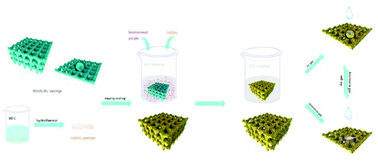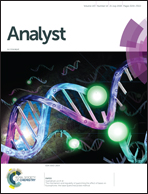A dual ammonia-responsive sponge sensor: preparation, transition mechanism and sensitivity†
Abstract
PDMS-PU (polydimethylsiloxane-polyurethane) sponge decorated with In(OH)3 (indium hydroxide) and BCP (bromocresol purple) particles is shown to be a room-temperature ammonia sensor with high sensitivity and excellent reproducibility; it can accomplish real-time detection and monitoring of ammonia in the surrounding environment. The superhydrophobic and yellowish In(OH)3-BCP-TiO2-based ammonia-responsive (IBT-AR) sponge changes to a purple superhydrophilic one when exposed to ammonia. Notably, after reacting with ammonia, the sponge can recover its original wettability and color after heating in air. The wettability, color and absorption signal of IBT-AR sponge have been measured for sensing ammonia using the water contact angle, macroscopic observation and UV-vis absorption spectrometry, respectively. The minimum ammonia concentrations that can be detected by the sponge wettability, color and absorption signal are 0.5%, 1.4 ppm and 50 ppb, respectively. This kind of sponge with smart wettability and color is a promising new ammonia detector.



 Please wait while we load your content...
Please wait while we load your content...